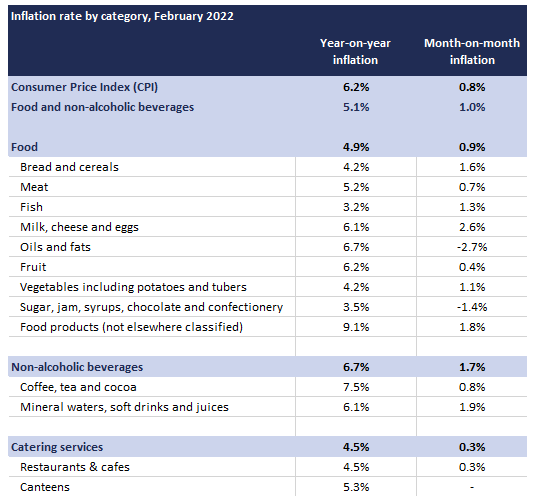Highest food inflation in 10 years
February prices for food and non-alcoholic beverages rose at the fastest annual rate since September 2011, reaching 5.1%, up from 4.4% in January. Prices increased in all product categories with the highest rise being recorded for lamb and goat (12.7%), low fat milk (11.1%), coffee (10.2%), pasta and couscous (9.4%), eggs (8.1%) and fruit (6.2%).
Topics
Inflation is set to continue as producer prices, which lead consumer prices, surged by 6.2% on the year. Further up the supply chain, food manufacturers faced more expensive ingredients in February, paying 6.8% more than a year ago for food ingredients produced in the UK and 8.9% more for those imported. But these increases only reflect changes brought on by the pandemic.
The Russian invasion of Ukraine has damaged the entire global food supply, so it’s certain the conflict will bring fresh inflationary pressures and supply chain disruptions. Food inflation for the medium term will be higher than what was expected a month ago, continuing to rise until the end of the year and will remain high until the end of 2023.
The immediate impact of the war resulted in the disruption to food supplies from Ukraine and Russia, most notably wheat, maize, sunflower oil and rapeseed oil. With the two countries producing 60% of the world’s sunflower oil and 14% of the global wheat production, this will have major implications for worldwide food supplies and security.
In the longer term, global food supply is threatened by the shortage of fertilisers. Nitrogen, one of the main types of fertilisers, relies on natural gas, and the spike in natural gas prices has already slowed down the production of nitrogen in Europe and North America. As for the other main fertiliser, potash, 39% of the global output is produced in Russia and Belarus, but that is no longer accessible. The significant drop in availability of fertiliser, both current and expected, led to fertiliser prices skyrocketing. In turn, the production of most agricultural products around the world will feel the shock. As the new planting season is upon us, UK and American farmers are already reporting using less fertiliser, which will result in lower crop yields. Animal feed requires fertiliser, so animal farmers will also feel the impacts. Moreover, these events are taking place against a backdrop of poor grain harvests in recent years and frantic buying behaviour during the pandemic.
In the wider economy, the cost of living is soaring. Besides pricier food, UK households had to pay higher prices for all other goods, especially for energy and durable goods, such as furniture. Headline annual inflation ran even higher in February, accelerating to 6.2% up from 5.5% in January. The Office for Budget Responsibility forecasts 2022 inflation at 7.4%.
Several measures announced today in the Spring Statement aimed to tackle the cost of living crisis. However, as the national insurance tax is due to rise in April, this means that most households will still feel the fiscal pinch.
The reality is that the sheer magnitude of price rises, those of today and to come, dwarfs any measure announced today. While current inflation is mainly due to causes global in nature, the UK Government can support the food and drink manufacturing sector by removing cost and complexity in upcoming regulation and establishing a National Food Security Council to enable the industry to respond rapidly to the impact of supply chain disruption, as well as protecting our nation’s food resilience and security.

